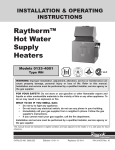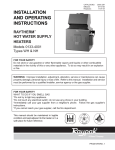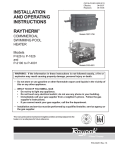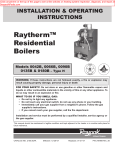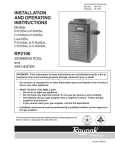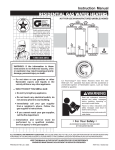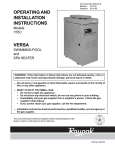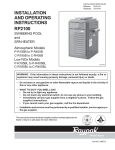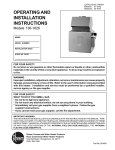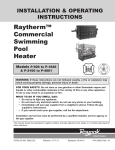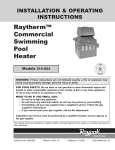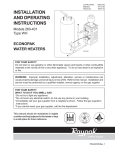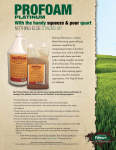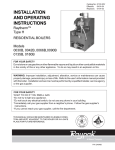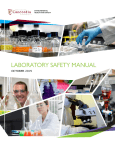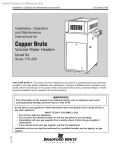Download Raypak 0133-4001 Operating instructions
Transcript
CATALOG NO. Effective: Replaces: 2000.50AB 08-14-07 11-15-05 INSTALLATION AND OPERATING INSTRUCTIONS RAYTHERM™ HEATING BOILERS Type H Models 0133-4001 FOR YOUR SAFETY Do not store or use gasoline or other flammable vapors and liquids or other combustible materials in the vicinity of this or any other appliance. To do so may result in an explosion or fire. WARNING: Improper installation, adjustment, alteration, service or maintenance can cause property damage, personal injury or loss of life. Refer to this manual. Installation and service must be performed by a qualified installer, service agency or the gas supplier. FOR YOUR SAFETY WHAT TO DO IF YOU SMELL GAS *Do not try to light any appliance. *Do not touch any electrical switch; do not use any phone in your building. *Immediately call your gas supplier from a neighbor's phone. Follow the gas supplier's instructions. *If you cannot reach your gas supplier, call the fire department. This manual should be maintained in legible condition and kept adjacent to the boiler or kept in a safe place for future reference. P/N 240035 Rev. 29 MODEL IDENTIFICATION The model number of a boiler can be found on the Sales Order and the boiler's rating plate. The example below identifies what the characters of the model number represent. Boiler rating plate showing model number MODEL NUMBER EXAMPLE: H3-0514A Series Model Size Representative of approximate MBTUH input (Model 0514 has input of 511,500 BTUH) Firing Mode 1 Mechanical Modulation 2 Motorized Modulation 3 2-Stage Firing / 4-Stage Firing Option 4 On-Off Firing 5 Low Temperature Mechanical Modulation 6 Motorized Modulation w/Electronic Outdoor Reset B6000 Application H = Heating Boiler TABLE OF CONTENTS MODEL IDENTIFICATION........................................................................................2 RECEIVING EQUIPMENT........................................................................................4 CERTIFICATIONS.................................................................................................... 4 BOILER TYPES........................................................................................................ 4 CALIFORNIA PROPOSITION 65 WARNING.......................................................... 4 INSTALLATION........................................................................................................ 5 Installation Codes...............................................................................................5 Installation Base................................................................................................. 5 Clearances......................................................................................................... 6 Combustion and Ventilation Air..........................................................................7 Venting................................................................................................................8 Plumbing.............................................................................................................15 CONTROLS.............................................................................................................. 21 Economaster Controls........................................................................................21 Electronic Ignition............................................................................................... 21 Operating Controls............................................................................................. 21 Limit Controls......................................................................................................22 ELECTRICAL CONNECTIONS................................................................................ 24 START-UP................................................................................................................ 25 Before Start-up................................................................................................... 25 Lighting Instructions........................................................................................... 26 After Start-up...................................................................................................... 28 Inspections......................................................................................................... 29 LOW NOx BOILERS.................................................................................................30 Operation............................................................................................................30 Start-up...............................................................................................................30 Burner Adjustment............................................................................................. 30 Visual Inspection................................................................................................ 30 Electrical............................................................................................................. 30 Flame Roll-out Safety Switch.............................................................................30 Service................................................................................................................31 TROUBLESHOOTING..............................................................................................32 Electrical............................................................................................................. 32 Mechanical......................................................................................................... 35 SERVICE.................................................................................................................. 36 Tube Cleaning Procedure..................................................................................36 Burner Tray Removal......................................................................................... 37 Gas Valve Removal........................................................................................... 37 Main Burner and Orifice Removal..................................................................... 37 Pilot Removal and Cleaning.............................................................................. 37 High Limit or Tankstat Removal........................................................................ 37 Heat Exchanger Removal..................................................................................37 Combustion Chamber Removal........................................................................ 38 Control Well Replacement................................................................................. 39 Tube Replacement Procedure...........................................................................39 Cleaning Flue Gas Passageways......................................................................39 REPLACEMENT PARTS..........................................................................................39 WARRANTY............................................................................................................. 40 3 RECEIVING EQUIPMENT BOILER TYPES On receipt of the equipment, visually check for external damage to the carton or the shipping crate. If either is damaged, make a note on the Bill of Lading and report the damage to the Carrier immediately. Remove the boiler from the carton or the shipping crate. On occasion, items are shipped loose. Be sure that you receive the number of packages indicated on the Bill of Lading. When ordering parts, you must specify the Model and Serial Number of the boiler. When ordering under warranty conditions, you must also specify the date of installation. Raypak recommends that this manual be reviewed thoroughly before installing your Raypak boiler. If there are any questions which this manual does not answer, please contact the factory or your local Raypak representative. Claims for shortages and damages must be filed with carrier by consignee. Permission to return goods must be factory authorized and are subject to a stocking charge. Purchased parts are subject to replacement only under the manufacturer's warranty. Debits for defective replacement parts will not be accepted and will be replaced in kind only per our standard warranties. TYPE H1 - MECHANICAL MODULATING Central heating boiler with 150°-210°F mechanical modulating gas valves and pressure relief valve. Standard on models 133-1826. TYPE H2 - MOTORIZED MODULATING Central heating boiler with a motorized modulating gas valve. Standard on models 21004001. Available as option on models 514-1826. Modulating controller provided. TYPE H3 - 2-STAGE CONTROLS Central heating boiler with single two-stage gas valve . Available as option on Models 183-4001. Twostage controller provided. Available with Y-1 sequencing option. TYPE H4 - ON-OFF CONTROLS Central heating boiler with on-off firing. Available as option on Models 181-4001. TYPE H5 - MECHANICAL MODULATING Central heating boiler with 110°-170°F mechanical modulating gas valves and pressure relief valve. Standard on Models 133-1826. CERTIFICATIONS The Raypak hydronic boilers are design certified and tested under the latest requirements of the American National Standard, ANSI Z21.13. Each boiler has been constructed and pressure tested in accordance with the requirements of Setion IV of the American Society of Mechanical Engineers Code, and factory fire tested. TYPE H6 - B6000 SYSTEM CONTROL Central heating boiler for use with the B6000 boiler management system. Available for Models 514-4001. TYPE H9 - 4-STAGE All models are National Board approved. Temperature and pressure gauge is standard. Model 0133 has a 4-pass heat exchanger, 1 tube per pass. Models 0181-1826 have 2-pass heat exchangers, 5 tubes first pass, 4 tubes second pass. Models 2100-4001 have 2-pass heat exchangers, 9 tubes per pass. Models 926-4001 have optional single-pass heat exchangers with cast iron headers only. Central heating boiler for use with 4-stage firing. Controller optional. Available option on Models 5144001. CALIFORNIA PROPOSITION 65 WARNING: This product contains chemicals known to the State of California to cause cancer, birth defects or other reproductive harm. 4 INSTALLATION INSTALLATION CODES The installation must conform with these instructions and the latest editions of the National Fuel Gas Code ANSI Z223.1, the National Electric Code ANSI/NFPA 70 and local codes. All boiler installations must conform to ASME boiler code. Hot water pipes must be installed with minimum clearances to combustible material as required by code. INSTALLATION BASE The boiler should be mounted on a level, non-combustible surface. Boiler must not be installed on carpeting. The boiler can be installed on a combustible surface only when a suitable floor shield base is provided. Raypak offers an optional floor shield base which can be factory installed on all indoor models except Model 133; the Model 133 floor shield base is shipped loose and must be installed by the contractor. Do NOT use the shipping crate base as an installation base. NOTE: The boiler should be located in an area where water leakage will not result in damage to the area adjacent to the appliance or to the structure. When such locations cannot be avoided, it is recommended that a suitable drain pan, adequately drained, be installed under the appliance. The pan must not restrict air flow. In addition, the boiler shall be installed such that the gas ignition system components are protected from water (dripping, spraying, rain, etc.) during appliance operation and service (circulator replacement, control replacement, etc.). Combustible Floor Shield ordering information: Boiler Model No. Base Part No. Boiler Model No. Base Part No. 133 182/181 260/261 330/331 400/401 001749 058313 058314 058315 058316 514 624 724 824 056199 056200 056201 056202 054597 054598 054599 054600 054601 058378 058379 926* 1083* 1178* 1287* 1414* 1571* 1758* 059233 962 059234 1125 059235 1223 059236 1336 059237 1468 059238 1631 059239 1826 * Models with factory-installed floor shield as standard. BOLD type indicates Low NOx models. ALTERNATE METHOD FOR PROVIDING A NON-COMBUSTIBLE BASE Fig. #8148.1 5 CLEARANCES REDUCTION OF CLEARANCES TO PROTECTED SURFACES CLEARANCES FROM COMBUSTIBLE SURFACES Note: The boiler shall be installed in a space large in comparison to the size of the boiler. Large space is defined as having a volume at least sixteen (16) times the total volume of the boiler. (All dimensions are in inches) 133 MODEL 181 to 514 to 926 to 2100 to 824 1826 4001 401 Derived from National Fuel Gas Code, Table 6.2.3(a) Note 1: Combustible floor shield is required when boiler is to be installed on a combustible surface. (See ordering information on pg. 4.) Note 2: Servicing Clearances: Provide at least 24" (Models 133-1826), 48" (Models 2100-4001) in front of unit for removal and servicing of the Controls & Burner Tray. Provide at least 18" on side opposite water connections for deliming of Heat Exchanger Tubes. *Vent includes factory-supplied drafthood and does not include field-supplied vent systems above the drafthood. On Models 2100-4001 drafthood is built into boiler. Derived from National Fuel Gas Code, Table 6.2.3(b) 6 OUTDOOR BOILERS These boilers are designed certified for outdoor installation. Boilers must not be installed under an overhang within three (3) feet from the top on the boiler. Three (3) sides must be open in the area under the overhang. Roof water drainage must be diverted away from the boilers with the use of gutters. The point from where the flue products exit the boiler must be a minimum of four (4) feet below, four (4) feet horizontally from or one (1) foot above any door, window or gravity inlet to a building. The top surface of the boiler shall be at least three (3) feet above any forced air inlet, or intake ducts located within ten (10) feet horizontally. Fig. #8245 Model Square Inches 133 136 182/181 181 260/261 264 330/331 334 400/401 399 514 512 624 627 724 726 824 825 962 962 HIGH-WIND CONDITIONS (Outdoor Units Only) In areas where high winds are frequent, it may be necessary to locate the boiler a minimum of 3' from high vertical walls, or install a wind break so the boiler is not in direct wind current. COMBUSTION AND VENTILATION AIR (Indoor Units Only) The boiler must have both combustion and ventilation air. Minimum requirements for net free air supply openings are 12 inches from ceiling for ventilation and 12 inches from the floor for combustion air as outlined in Z223.1 - latest edition and any local codes that may have jurisdiction. Model 1125 1223 1336 1468 1631 1826 2100 2500 3001 3500 4001 Square Inches 1125 1223 1337 1467 1630 1826 2100 2499 3000 3500 4000 b. All Air From Outdoors: When air is supplied directly from outside of building, each opening shall have a minimum net free square inches as noted: CAUTION: Combustion air must not be contaminated by corrosive chemical fumes which can damage the boiler and void the warranty. Model Square Inches 133 34 182/181 46 260/261 66 330/331 84 400/401 100 514 128 624 157 724 182 824 207 962 241 a. All Air From Inside The Building: Each opening shall have a minimum net free square inches as noted: 7 Model 1125 1223 1336 1468 1631 1826 2100 2500 3001 3500 4001 Square Inches 282 306 335 367 408 457 525 625 750 875 1000 VENTING OUTDOOR INSTALLATIONS MODEL 133 Step 1: Remove the front (4) screws. Step 2: Line up outdoor top vent opening over heater vent opening. Step 3: Lower outdoor top onto unit lining up slots in the outdoor top with screws holes in jacket top. Step 4: Reinstall (5) screws to secure jacket top and outdoor top to unit. Fig. #RP8280.1 Detail A Detail B Outdoor Top (Shipped Loose with Heater) MODELS 514 - 824 Step 1: Lower outdoor top onto unit. Position top so it is centered on unit from side to side and front to rear. Fig. #8114 MODELS 181-401 and 182-400 Outdoor Top Installation Fig. # 8166.1 Step 2: Tighten the (4) screws (Shown below) until they come in contact with the unit jacket top, then evenly tighten all (4) screws to secure to unit. (Part of heater) JACKET TOP Fig. # 9389 FASTENING SCREW Step 1: Remove jacket top panel. Step 2: Remove and discard inner stack adapter panel. Step 3: Install jacket top panel. Step 4: Insert tabs of outdoor top into keyholes located on jacket top panel (4 places). See Detail A Step 5: Snap tabs on outdoor top into the locked postion of the keyhole so the top will not pull out. See Detail B Fig. # 8233 MODELS 926-1758 Boilers are shipped with outdoor vent terminal factory installed. 8 INDOOR INSTALLATIONS MODEL 133 Step 1. Step 2. Step 3. Step 4. Shut-off main electrical power switch to boiler. Turn heater manual switch located in upper control panel to the "OFF" position. Shut-off gas supply and water supply to the boiler. Mount drafthood on boiler and attach with the sheet metal screws provided. Drafthood should be positioned with the vent sensor located on the front left side as shown below. Step 5. Remove plastic plug from left side of boiler jacket and install the plastic grommet provided. Step 6. Route flue sensor wire harness through the grommet installed in Step 5. Step 7. Remove door and locate wire from roll-out sensor to high limit with the male/female connector. Fig. #8946 Step 8. Disconnect male/female connector and attach to the 2 wires from drafthood vent sensor harness. 9 MODELS 181-401 and 182-400 INDOOR STACK INSTALLATION 1. Remove the louvered jacket top by removing four (4) #10 flathead screws. 2. If originally installed, remove outdoor top from the louvered jacket top. 3. Place the inner stack adapter panel over the flue collector inside the heater. Make sure the flanged side of the flue opening is up. 4. Turn the stack (drafthood) upside down and set it down bottom side up. 5. Turn the jacket top panel (removed in step 1) upside down and place it through the stack. 6. Attach the three (3) mounting brackets to the stack using the screws provided and the holes that are pre-drilled in the stack. Make sure the brackets are positioned with the flange near the top side of the stack (see illustration). Caution must be taken not to over tighten and strip the screw threads. 7. Turn the assembled stack and jacket top, rightside up. The jacket top will be trapped between the brackets and the top of the stack. Place the stack over the inner stack adapter panel flanged hole and lower the louvered jacket top panel back into its original position. Reinstall the four (4) #10 flathead screws removed in step 1 above. Fig. #8246.5 10 MODELS 181-401 and 182-400 Step 1. Step 2. Step 3. Step 4. Step 5. Step 6. Step 7. Step 8. Shut-off main electrical power switch to boiler. Turn heater manual switch located in upper control panel to the "OFF" position. Shut-off gas supply and water supply to the boiler. Mount drafthood on top of boiler as shown on page 8. Drafthood should be positioned with the vent sensor located on the front right side as shown. Remove plastic plug from left side of boiler jacket and install plastic grommet provided. Route flue sensor wire harness through the grommet installed in Step 5. Remove door and locate wire from roll-out sensor to high limit with the male/female connector. Disconnect male/female connector and attach to the 2 wires from drafthood vent sensor harness. BOILER BEFORE DRAFTHOOD INSTALLATION Fig# 9349 BOILER AFTER DRAFTHOOD INSTALLATION Fig# 9351 11 MODELS 514-824 MODELS 2100-4001 Locate and assemble as shown below. Secure with screws supplied in envelope in carton. These models have built-in drafthoods. For proper operation, the drafthood outlet must be connected to the venting system. VENT PIPING WARNING: Indoor boilers require a drafthood that must be connected to a vent pipe and properly vented to the outside. Failure to follow this procedure can cause fire or fatal carbon monoxide poisoning. Vent piping the same size or larger than the drafthood outlet is recommended, however, when the total vent height is at least 10 ft. (drafthood relief opening to vent terminal), the vent pipe size may be reduced as specified in Chapter 10 of the latest edition of the National Fuel Gas Code, ANSI Z223.1. As much as possible avoid long horizontal runs of vent pipe and too many elbows. If installation requires horizontal non-vertical runs, the vent pipe must have a minimum of 1/4 inch per foot rise and should be supported at not more than 5 ft. intervals. Plumbers tape, criss-crossed, will serve to space both horizontal and vertical piping. Gas vents supported only by the flashing and extending above the roof more than 5 ft. should be securely guyed or braced to withstand snow and wind loads. We recommend the use of insulated vent pipe spacers through the roof and walls. For protection against rain or blockage by snow, the vent pipe must terminate with a vent cap which complies with the local codes or, in the absence of such codes, to the latest edition of the National Fuel Gas Code, ANSI Z223.1. The discharge opening must be a minimum of 2 ft. vertically from the roof surface and at least 2 ft. higher than any part of the building within 10 ft. Fig. # 8167.0 MODELS 962-1826 Locate and assemble as shown below. Secure with screws supplied in envelope in carton. Fig. # 8165.0 12 10' or less Vent stack shall be at least 5 ft. in vertical height above the drafthood outlet. The vent cap location shall have a minimum clearance of 4 feet horizontally from, and in no case above or below, unless a 4-foot horizontal distance is maintained, from electric meters, gas meters regulators and relief equipment. The weight of the vent stack or chimney must not rest on boiler drafthood. Support must be provided in compliance with applicable codes. The boiler top and drafthood must be readily removable for maintenance and inspection. Vent pipe should be adequately supported to maintain proper clearances from combustible construction. Type "B" double-wall or equivalent vent pipe is recommended. However single-wall metal vent pipe may be used as specified in the latest edition of the National Flue Gas Code ANSI Z223.1. Vent Cap 2' min. 2' min. 5' min. Vent Pipe Drafthood Heater Manifolds that connect more than one boiler to a common chimney must be sized to handle the combined load. Consult available guides for proper sizing of the manifold and the chimney. At no time should the area be less than the area of the largest outlet. Fig. #8119.0 (d) (e) (f) Fig. #7043.1 At the time of removal of an existing boiler, the following steps shall be followed with each appliance remaining connected to the common venting system placed in operation, while the other appliances remaining connected to the common venting system are not in operation. (a) Seal any unused openings in the common venting system. (b) Visually inspect the venting system for proper size and horizontal pitch and make sure there is no blockage or restriction, leakage, corrosion and other deficiencies which could cause an unsafe condition. (c) Insofar as is practical, close all building doors and windows and all doors between the space in which the appliances remaining connected to the common venting system are located and other spaces of the building. Turn on clothes dryers and any (g) appliance not connected to the common venting system. Turn on any exhaust fans, such as range hoods and bathroom exhausts, so they will operate at maximum speed. Do not operate a summer exhaust fan. Close fireplace dampers. Place in operation the appliance being inspected. Follow the lighting instructions. Adjust thermostat so appliance will operate continuously. Test for spillage at the drafthood relief opening after 5 minutes of main burner operation. Use the flame of a match or candle, or smoke from a cigarette, cigar or pipe. After it has been determined that each appliance remaining connected to the common venting system properly vents when tested as outlined above, return doors, windows, exhaust fans, fireplace dampers and any other gas burning appliance to their previous conditions of use. Any improper operation of the common venting system should be corrected so that the installation conforms with the latest edition of the National Fuel Gas Code, ANSI Z223.1. When re-sizing any portion of the common venting system, the common venting system should be re-sized to approach the minimum size as determined using the appropriate tables in Part 11 of the National Fuel Gas Code, ANSI Z223.1. For special venting applications that require reduced vent sizes and through-the-wall venting, the Type D Induced Draft Assembly can be used. Consult the factory or your local Raypak representative. 13 VENT DAMPER INSTALLATION (MODELS 133 THROUGH 261) WHERE REQUIRED LOCATION The vent damper must be located in the vent so that it serves only the appliance for which it is intended. If improperly installed, a hazardous condition, such as an explosion or carbon monoxide poisoning, could result. Make certain that it is mounted in an accessible location at least 6 inches from any combustible material or the heat exchanger, and that the position indicator is in a visible location. The vent damper must be installed after the appliance drafthood, as close to the drafthood as practicable, and without modification of the drafthood. Fig. # 8182.0 Note: Model 133 drafthood shown. WARNING: Do not use thermally actuated vent dampers on a modulating boiler. To do so, may result in asphyxiation. Use only a mechanically actuated vent damper device that is electrically interlocked with the modulating boiler operation. On vertical vents, the vent damper may be mounted with the actuator in any position. On horizontal vents, do not mount the actuator either directly above or directly below the vent pipe; mount the vent damper actuator to the side of the vent. The vent damper is set up for a continuous pilot system. If the vent damper is installed on an Intermittent Pilot or Direct Spark Ignition equipped system, the energy savings of the vent damper can be improved by plugging the hole in the vent damper blade using the knockout plug, Part No. 105612R, provided in the parts envelope. DO NOT plug the hole if installing the vent damper on a continuous pilot system as this will create a hazard. HORIZONTAL INSTALLATION FLOW > D808 NO N.O. N.C. End YES TO BOILER D808 1K2 Switch YES C. 1K1 TO CHIMNEY Motor R NO VERTICAL 1K3 1R INSTALL VENT INSTALLATION TO CHIMNEY DAMPER WITH 1 2 3 ACTUATOR TO Black SIDES OF VENT Orange 5 Blue Optional Limit Limit ONLY. DO NOT D808 4 Yellow Red Location Thermostat or MOUNT ABOVE OR Controller BELOW VENT. L1 (Hot) Dual Valve Control or INSTALLED IN ANY TO BOILER L2 Combination Gas ACTUATOR MAY BE 1 Transformer Ignition System POSITION ON 1 VERTICAL PIPE. Fig. # 8183.0 Power provide disconnect me means an overload ans an overload protection as requ Powersupply supply provide disconnect protection as required. ired. Fig. # 8615.0 VENT DAMPER INSTALLATION VENT DAMPER GENERAL WIRING DIAGRAM 14 INSTALL THE VENT DAMPER TO SERVICE ONLY THE SINGLE APPLIANCE FOR WHICH IT IS INTENDED. IF IMPROPERLY INSTALLED, A HAZARDOUS CONDITION, SUCH AS AN EXPLOSION OR CARBON MONOXIDE POISONING, COULD RESULT. VENT DAMPER NORMAL OPERATION SUMMARY For safe, efficient operation, the vent damper and all flue product carrying areas of the appliance must be checked annually, with particular attention given to deterioration from corrosion or other sources. Check vent damper operation as follows: 1. When the boiler is off, check that the vent damper position indicator points to the closed position. (See figure below.) 2. Turn the thermostat or controller up to call for heat and check that the vent damper indicator points to the open position. (See figure below.) 3. Turn the thermostat or controller down again and check that the vent damper position indicator returns to the closed position. EFFIKAL® RVGP THE VENT DAMPER MUST BE INSPECTED AT LEAST ONCE A YEAR BY A TRAINED, EXPERIENCED SERVICE TECHNICIAN. THE NAME OF THE PERSON WHO ORIGINALLY INSTALLED YOUR VENT DAMPER IS SHOWN ON THE INSTALLATION LABEL. DAMPER MUST BE IN OPEN POSITION WHEN BOILER MAIN BURNERS ARE OPERATING. Damper Position Indicator Damper Position Indicator Fig. # 8181.0 DAMPER OPEN CONNECTION DIAGRAM FOR EFFIKAL® VENT DAMPER DAMPER CLOSED VENT DAMPER POSITON INDICATOR PLUMBING GAS SUPPLY CONNECTIONS Gas piping must have a sediment trap ahead of the boiler gas controls, and a manual shut-off valve located outside the heater jacket. All gas piping should be tested after installation in accordance with local codes. CAUTION: The boiler and its manual shut-off valve must be disconnected from the gas supply during any pressure testing of that system at test pressures in excess of 1/2 PSIG. Dissipate test pressure in the gas supply line before reconnecting the boiler and its manual shut-off valve to gas supply line. FAILURE TO FOLLOW THIS PROCEDURE MAY DAMAGE THE GAS VALVE. OVER PRESSURED GAS VALVES ARE NOT COVERED BY WARRANTY. The boiler and its gas connections shall be leak tested before placing the appliance in operation. Use soapy water for leak test do NOT use open flame. NOTE: Do not use teflon tape on gas line pipe thread. A flexible sealant is recommended. Fig. # 8090.1 15 A minimum of 7" W.C. and a maximum of 10.5" W.C. upstream pressure, under load and no-load conditions, must be provided for natural gas, or a minimum of 12" W.C. and a maximum of 13" for propane. *Low NOx units not available for propane. GAS PRESSURE REGULATOR The gas pressure regulator is preset nominally at 4" W.C. for natural gas, and 11" W.C. for propane. Between the gas valve and the burners is a 1/8" pipe plug. The pressure at this point, taken with a manometer, should be about 3.7" W.C. for natural gas and 10.5" W.C. for propane. Low NOx models should be 3.9" W.C., natural gas only. If an adjustment is needed, turn adjustment screw clockwise to increase pressure, or counter-clockwise to decrease pressure. For boilers with mechanical modulation gas valves (Type H1 and H5) or two-stage gas valves (Type H3), the gas pressure regulator is preset and sealed, and not field adjustable. Pressure tap is provided on the outlet side of the gas valve for measurement of gas pressure in the manifold. VENTING OF DIAPHRAGM GAS COMPONENTS Gas valves that are equipped with a gas bleed must be vented to the outdoors as required by the National Fuel Gas Code. Under NO circumstances shall bleed lines terminate in the gas utilization equipment flue or exhaust system. Bleed Line Connection Fig. # 8185.2 GENERAL Boiler should be located so that any water leaks will not cause damage to any adjacent areas or structures. See piping diagrams for proper water connections for the type of boiler and system. 16 EXCHANGER PUMP SELECTION In order to ensure proper hydraulics in your hydronic heating system, adequate pump size must be selected. We recommend that the pump be sized for 20°F Delta T. (Delta T is the temperature difference between the inlet and outlet water when the boiler is firing at full rate). For some boilers, the Delta T is more than 20°F (22°-33°F) at the recommended flow rates. RECOMMENDED PURGE MANIFOLDS FOR TYPICAL HYDRONIC SYSTEM HOOKUPS The boiler piping system of a hot water heating boiler connected to heating coils located in air handling units where they may be exposed to refrigerated air circulating, must be equipped with flow control valves or other automatic means to prevent gravity circulation of the boiler water during the cooling cycle. FEEDWATER REGULATOR We recommend that a feedwater regulator be installed and set at 12 PSIG minimum pressure. Install a check valve or back flow device upstream of the regulator, with a manual shut-off valve. Leave the valve open. TEMPERATURE & PRESSURE GAUGE The temperature & pressure gauge is standard equipment on all hydronic heating and hot water supply boilers. All temperature & pressure gauges are factory mounted in the in/out header except for residential boilers, Models 133 and 181-401. On these models the temperature & pressure gauge is shipped loose for field installation, and located in the outlet water connection. All fittings required to mount gauge to piping system are supplied by others. PIPING - HEATING BOILERS We recommend that all high points be vented and that purge valves and a bypass valve be installed. A boiler installed above radiation level must be provided with a low water cut-off device. The boiler, when used in conjunction with a refrigeration system, must be installed so that the chilled medium is piped in parallel with the boiler with appropriate valves to prevent the chilled medium from entering the boiler. 17 PIPING DIAGRAMS DIAPHRAGM TANK SYSTEM 7024e NOTE: Expansion tanks (supplied by others) should be installed per manufacturer's instructions. 18 MULTI-ZONE HEATING SYSTEMS MODELS 133 TO 4001 Fig.# 7027.1e NOTE: Expansion tanks (supplied by others) should be installed per manufacturer's instructions. Fig.# 7024.1e NOTE: Expansion tanks (supplied by others) should be installed per manufacturer's instructions. 19 MULTIPLE-BOILER– REVERSE RETURN HOOK-UP MODELS 133 TO 4001 REVERSE RETURN PIPING IS A PROPER METHOD OF MANIFOLDING MULTIPLE BOILER HOOK-UPS TO ENSURE BALANCED FLOW THROUGH EACH BOILER. VALVES ON SUPPLY AND RETURN ARE NEEDED TO ISOLATE ANY BOILER, AS REQUIRED. 20 CONTROLS OPERATING CONTROLS ECONOMASTER CONTROLS Models 133-1826 with mechanical modulating controls have one or more Robertshaw Unitrol 7000 Series hydraulic snap-on thermostatic combination gas valves. These valves have the pressure regulator and 24 volt operator built-in. The hydraulic actuator will throttle the boiler input to adjust the firing rate and meet the required load. This, in effect, prevents costly fuel consumption, as compared to an on-off cycling boiler. The valve has a remote capillary bulb immersed in a well, at the header outlet, to maintain a constant outlet water temperature. When multiple valves are furnished, they can be staged to give greater flexibility of control. Standard factory setting is at position 5. Consult the dial setting tag attached to the control for your desired temperature. See sample tag drawings below. The Economaster II is an electronic device that allows the operator to set the desired time for the pump to run after the boiler shuts off. The time is factory-set at 7 minutes and it can be re-adjusted in the field anywhere from 3 to 10 minutes. In a conventional system, when the aquastat is satisfied, the main gas valve closes, but the pump continues operating. With the new energy-conserving Economaster II the boiler pump is programmed to continue running for an optimum period of time in order to absorb the residual heat from the combustion chamber and use it in the system. The pump then shuts off until the next call for heat is received from the aquastat. 3/4 NOTE: Pump will come on when power is first applied to boiler. Fig. #8645.1 ACAD: ECONO. DWG. ELECTRONIC IGNITION LOW TEMP. RANGE HIGH TEMP. RANGE The intermittent ignition device conserves energy by automatically extinguishing the pilot when desired temperature is reached. When additional heat is needed, the pilot re-ignites electrically, eliminating the fuel costs of maintaining a constant pilot. To ensure safe operation, the gas valve cannot open until the pilot relights and is proven. All units are shipped with lockout ignition module as standard. IGNITION MODULE ELECTRONIC SAFETY Fig. #8645 21 Fig. # 8929.1 MODULATING VALVES W/ BUILT-IN REGULATOR Fig. #8643 MODULATING VALVE LOCATION THERMOSTAT CONTROL LIMIT CONTROLS HIGH LIMIT The boiler is equipped with a manual reset high limit. Push the reset button and set the limit(s) to 3040 °F above desired operating temperature. rupted. Pilot flame is automatically lit when the device is powered. Unit performs its own safety check and opens the main valve only after the pilot is proven to be lit. FLOW SWITCH This dual purpose control shuts off the boiler in the case of a pump failure or low water condition. It is mounted and wired in series to the main gas valve. Standard on all models except the 133. NOTE: Flow switch will not operate if flow is less than 12 GPM. LOW WATER CUT-OFF (OPTIONAL) The low water cut-off automatically shuts down burner whenever water level drops below probe. 90second time delay prevents premature lockout due to temporary conditions such as power failure or air pockets. Flush float type devices at beginning of each heating season. 100% PILOT SAFETY All standard boiler models 514-4001 employ electronic devices which close the main gas valve within 8/10 of a second whenever the pilot flame is inter- HIGH AND LOW GAS PRESSURE SWITCHES These switches sense either high or low gas pressures and automatically shut down burners if abnormal pressures exist. MANUAL RESET HIGH LIMIT FLOW SWITCH Fig. #8644 22 MODULATING VALVE Fig. #8995 LOW WATER CUT-OFF GAS PRESSURE SWITCH Fig. #8996 Fig. #8236 23 ELECTRICAL CONNECTIONS Boiler must be electrically grounded in accordance with National Electrical Code ANSI/NFPA No 70. CAUTION: Label all wires prior to disconnection when servicing controls. Wiring errors can cause improper and dangerous operation. Verify proper operation after servicing. DANGER - SHOCK HAZARD Make sure electrical power to the heater is disconnected to avoid potential serious injury or damage to components. The boiler is normally wired for 120 Volts. The voltage is indicated on the tie-in leads. Consult the wiring diagram shipped with the boiler in the instruction packet. The "TH" leads are for the remote tank control connection. 24 Volts are supplied to this connection through the boiler transformer. DO NOT attach line voltage to the "TH" leads on models 133-1826. Before starting boiler check to ensure proper voltage to boiler and pump. Fig. #9138.1 NOTES: 1. Field install ground to inside of junction box. 2. If any of the original wire as supplied with the boiler must be replaced, it must be replaced with 105°C wire or its equivalent. - Fig. #9138.2 24 START-UP HIGH LIMIT Fig. #8991 ETHYLENE GLYCOL SYSTEMS HEATING BOILERS Fill through filler opening on the top on the Air-X Tank to solution desired. Always maintain solution level in sight glass. BEFORE START-UP Safe lighting and other performance criteria were met with the gas manifold and control assembly provided on the boiler when the boiler underwent tests specified in the latest edition of ANSI-Z21.13 Standard. INITIAL START-UP - PUMP AND MOTOR Many pumps are now direct-drive. They have no coupler or bearing assembly. These pumps do not require lubrication. Others require SAE-30 non-detergent oil to lubricate both the motor and the bearing assembly. Check pump motor for type before attempting to oil. Clean dust and lint from pump and motor. Check pump coupler and tighten if necessary. Flush system before putting into operation to ensure that foreign material does not damage pump seals. GENERAL Before lighting up a new installation, water should be flowing through the boiler. Regulator should be set to minimum 12 PSI. CAUTION: Liquefied petroleum gas is heavier than air and sinks to the ground. Exercise extreme care in lighting boiler in confined areas. FILLING SYSTEM - HEATING BOILERS Fill system with water. Purge all air from the system using purge valve sequence. After system is purged of air, lower system pressure. Open valves for normal system operation. Fill system through feed pressure. Manually open air vent on the compression tank until water appears, then close vent. CAUTION: A. Pump must be off to check oil in bearing assembly. B. Do not run pump without water in system. 25 START-UP LIGHTING INSTRUCTIONS FOR BOILERS WITH STANDING PILOT. For Models 133, 182, 260, 330 & 400 FOR YOUR SAFETY READ BEFORE LIGHTING WARNING: If you do not follow these instructions exactly, a fire or explosion may result causing property damage, personal injury or loss of life. A. This appliance has a pilot which must be lighted by hand. When lighting the pilot, follow these instructions exactly. • If you cannot reach your gas supplier, call the fire department. C. Use only your hand to push in or turn the gas control knob. Never use tools. If the knob will not push in or turn by hand, don’t try to repair it, call a qualified service technician. Force or attempted repair may result in a fire or explosion. B. BEFORE LIGHTING smell all around the appliance area for gas. Be sure to smell next to the floor because some gas is heavier than air and will settle on the floor. WHAT TO DO IF YOU SMELL GAS • Do not try to light any appliance. • Do not touch any electric switch; do not use any phone in your building. • Immediately call your gas supplier from a neighbor’s phone. Follow the gas supplier’s instructions. D. Do not use this appliance if any part has been under water. Immediately call a qualified service technician to inspect the appliance and to replace any part of the control system and any gas control which has been under water. LIGHTING INSTRUCTIONS 1. STOP! Read the safety information above on this label. 2. Set the thermostat to lowest setting. 3. Turn off all electric power to the appliance. 4. Remove boiler door panel. 5. Push in gas control knob slightly and turn clockwise to “OFF”. GAS CONTROL KNOB SHOWN IN "OFF" POSITION GAS INLET PILOT BURNER 7. Locate pilot mounted on the right side of the burner tray, and right of first burner. 8. Turn knob on gas control counter-clockwise to "PILOT" 9. Push in control knob all the way and hold in . GAS CONTROL KNOB SHOWN IN "OFF" POSITION Fig. # 8081.0 GAS INLET THERMOCOUPLE Fig. # 8243.0 NOTE: Knob cannot be turned from “PILOT” to “OFF” unless knob is pushed in slightly. Do not force. 6. Wait five (5) minutes to clear out any gas. Then smell for gas, including near the floor. If you smell gas, STOP! Follow “B” in the safety information above on this label. If you don’t smell gas, go to next step. 10. 11 12. 13 Immediately light the pilot with a match. Continue to hold the control knob in for about one (1) minute after the pilot is lit. Release knob and it will pop back up. Pilot should remain lit. If it goes out, repeat steps 5 through 9. • If knob does not pop up when released, stop and immediately call your service technician or gas supplier. • If the pilot will not stay lit after several tries, turn the gas control knob to “OFF” and call your service technician or gas supplier. Stand to the side of the boiler and turn the gas control knob counter-clockwise to "ON". Replace boiler door panel. Turn on all electric power to the appliance. Set the thermostat to the desired setting. TO TURN OFF GAS TO APPLIANCE 1. Set the thermostat to lowest setting. 2. Turn off all electric power to the appliance. 3. Remove boiler door. 4. Push in gas control knob slightly and turn clockwise to “OFF”. Do not force. 5. Replace boiler door panel. 26 LIGHTING INSTRUCTIONS FOR BOILERS WITH ELECTRONIC IGNITION (IID) For Models with Manual Gas Valves FOR YOUR SAFETY READ BEFORE OPERATING WARNING: If you do not follow these instructions exactly, a fire or explosion may result causing property damage, personal injury or loss of life. A. This appliance is equipped with an ignition device which automatically lights the pilot. Do not try to light the pilot by hand. B. BEFORE OPERATING smell all around the appliance area for gas. Be sure to smell next to the floor because some gas is heavier than air and will settle on the floor. WHAT TO DO IF YOU SMELL GAS Do not try to light any appliance. Do not touch any electric switch; do not use any phone in your building. Immediately call your gas supplier from your neighbor’s phone. Follow the gas supplier’s instructions. * * * * If you cannot reach your gas supplier, call the fire department. C. Use only your hand to push in or turn the gas control knob. Never use tools. If the knob will not push in or turn by hand, do not try to repair it, call a qualified service technician. Force or attempted repair may result in a fire or explosion. D. Do not use this appliance if any part has been under water. Immediately call a qualified service technician to inspect the appliance and to replace any part of the control system and any gas control which has been under water. OPERATING INSTRUCTIONS 1. 2. 3. 4. 5. 6. 7. 8. STOP! Read the safety information above. Set the thermostat on the lowest setting. Turn off all electrical power to the appliance. This appliance is equipped with an ignition device which automatically lights the pilot. Do not try to light the pilot by hand. Remove boiler door panel. For Robertshaw gas valve: Turn gas control knob clockwise to “OFF”. For Honeywell gas valve (all models except 40#): Turn gas control knob clockwise to “OFF". Make sure knob rest against stop. For Honeywell gas valve (Models 40# only): Push in gas control knob slightly and turn clockwise to “OFF”. Knob cannot be turned to “OFF” unless knob is pushed in slightly. Do not force. Wait five (5) minutes to clear out any gas. Then smell for gas, including near the floor. If you smell gas, STOP! Follow “B” in the safety information above. If you do not smell gas, go to the next step. For Robertshaw gas valve: Turn gas control knob counter-clockwise to “ON”. For Honeywell gas valve: Turn gas control knob counter-clockwise from “OFF” until it stops. Push in gas control knob and continue rotating counter-clockwise to “ON” position. Make sure knob rests against stop. HONEYWELL GAS CONTROL KNOB SHOWN IN "ON" POSITION GAS INLET Fig. # 8082 For Honeywell gas valve (Models 40# only): Turn gas control knob counter-clockwise to “ON”. GAS CONTROL KNOB SHOWN IN "ON" POSITION GAS INLET ROBERTSHAW GAS CONTROL KNOB SHOWN IN "ON" POSITION 9. 10. 11. 12. GAS INLET Fig. # 8080 Fig. #8219 Replace boiler door panel. Turn on all electrical power to the appliance. Set thermostat to desired setting. If the appliance will not operate, follow the instructions “To Turn Off Gas To Appliance” and call your service technician or gas supplier. TO TURN OFF GAS TO APPLIANCE 1. 2. 3. 4. Set the thermostat to the lowest setting. Turn off all the electrical power to the appliance if service is to be performed. Remove door panel. For Robertshaw gas valve: Turn gas control knob clockwise to “OFF”. For Honeywell gas valve (all models except 40#): 5. 27 Turn gas control knob clock-wise to “OFF”. Make sure knob rests against stop. For Honeywell gas valve (Models 40# only): Push in gas control knob slightly and turn clockwise to “OFF”. Replace heater door panel. FOR MODELS WITH AUTOMATIC GAS VALVES LIGHTING INSTRUCTIONS 3. Open main gas valve. 4. Set temperature controls to desired temperature. 1. Close all gas valves. Turn off electrical power supply. Wait five (5) minutes. 2. Open manual pilot valve. Turn on electrical power. Pilot is automatically lighted. PILOT VALVE CONTROL SHOWN IN THE "ON" POSITION TO SHUT DOWN Close all manual gas valves. Turn off electrical power. MAIN GAS SHUT-OFF VALVE SHOWN IN THE "ON" POSITION IGNITION MODULE GAS INLET Fig. # 8220.0 Fig. # 8929.1 AFTER START-UP INTERMITTENT PILOT SYSTEM CHECKOUT (S8600) 1. Turn on power to the ignition systems and turn gas supply off. 2. Check ignition module as follows: a. Set the thermostat or controller above room temperature to call for heat. b. Watch for continuous spark at the pilot burner. c. Time the spark operation. Time must be within the lockout timing period (15 or 90 seconds). d. Turn thermostat down to end call for heat and wait 60 seconds on lockout models before beginning step 3. 3. Turn on gas supply. 4. Set thermostat or controller above room temperature to call for heat. 5. Systems should start as follows: a. Spark will turn on and pilot gas valve will open at once. Pilot burner should ignite after gas reaches the pilot burner. b. Spark ignition should cut-off when pilot flame is established. c. Main gas valve should open and main burner should ignite after gas reaches the burner port. STANDING PILOT CHECKOUT PROCEDURE 1. Turn on pilot gas supply, light pilot, and check pilot tubing connections for leakage. With main burner in operation, paint tubing connections with a rich soap and water solution. Bubbles indicate a gas leak. 2. Adjust pilot to obtain a normal flame enveloping 3/8 to 1/2 inch [9.5 to 12.5 mm] of the thermcouple or generator tip. 3. Place system in operation, and: a. Check for satisfactory ignition of main burner. b. Make certain the pilotstat "holds in", and that shutdown occurs within 2-1/2 minutes after the pilot flame is extinguished. c. Observe operation for at least three cycles to be sure the system is functioning normally. PILOT FLAME SHOULD ENGULF THERMOCOUPLE PILOT WITH BURNER FLAME Fig. # 8186.1 STANDING PILOT 28 CONTROLS Check all controls to see that they are operational. To check electronic safety (IID Models), turn off main burner. Observe pilot burner when shutting off pilot gas. Ignition spark should go on. Main gas valve will also drop out. To check high limit switch, turn dial setting down to a point slightly below the temperature of the water leaving the heater. The reset button should snap out and the burner should shut-off. Reset dial to 30°F to 40°F above desired operating temperature, and push reset button. Burner should light. INSPECTIONS BURNERS Clean main burners and air louvers of dust, lint and debris. Keep boiler area clear and free from combustibles and flammable liquids. Do not obstruct the flow of combustion and ventilation air. Make visual check of burner and pilot flame. Yellow flame indicates clogging of air openings. Lifting or blowing flame indicates high gas pressure. Low flame indicates low gas pressure. TYPICAL MAIN BURNER FLAME SUGGESTED INSPECTION SCHEDULE The boiler should be inspected on the first and third months after initial start-up and then on an annual basis. If problems are found, refer to Troubleshooting Guide for additional directions. 1. Remove top of heater and inspect heat exchanger for soot and examine venting system. 2. Remove rear header and inspect for scale deposits, and/or accelerated erosion. *3. Inspect pilot and main burner flame and firing rate. *4. Inspect and operate all controls and gas valve. *5. Visually inspect system for water leaks. *6. a. Oil pump motor and bearing assembly, if oil cups are provided. b. Disconnect pump from header and check condition of pump impeller. Check condition of bearing by attempting to move impeller from side to side. Replace any parts showing wear. c. Check pump coupler for wear and vibration. 7. Check flow switch paddle. 8. Clean room air intake openings to ensure adequate flow of combustion and ventilation air. CAUTION: Combustion air must not be contaminated by corrosive chemical fumes which can damage the boiler and void the warranty. 9. Keep boiler area clear and free from combustible materials, gasoline, and other flammable vapors and liquids. *Should be checked monthly. (Takes approximately 15 minutes). Fig. # 8144 NOTE: Modulating burner flame varies in height from approximately 1/4" at low fire to approximately 4" at high fire. Fig #9336 PILOT BURNER FLAME (IID UNITS) Fig #8964.1 PILOT BURNER FLAME (STANDING PILOT UNITS) 29 LOW NOx BOILERS Models 181 to 401 The boilers are certified and tested under the latest edition of the ANSI Z21.13 standards for hot water boilers. BURNER ADJUSTMENT This burner assembly does not require any primary air adjustments. The boiler should be installed to meet the latest edition of all local codes, the National Fuel Gas Code Z223.1 and the National Electrical Code, ANSI/NFPA 70. VISUAL INSPECTION Flame can be observed through the slot opening above the plenum. Flame color is blue and evenly spread on the top surface of the burner. At least every three months a visual inspection should be made of the burners. In case flame lifting is observed, check gas pressure on manifold and static pressure in plenum. Gas pressure in manifold should be 3.9" W.C. and static pressure in plenum should be greater than 0.5" W.C. ELECTRICAL Be sure that electrical service to the boiler has proper overload fuse or circuit breaker protection and wire size, and connections which comply with all applicable codes. FLAME ROLL-OUT SAFETY SWITCH The boiler is equipped with a cut-off device to prevent flame roll-out in the event the heat exchanger becomes blocked. This is a "manual reset" type roll-out switch, that must be reset by a service technician after any over temperature conditions have been fixed. Excessive restriction in the heat exchanger flue passage may cause the switch to disable the boiler. Fig # 9361 OPERATION On call for heat, the ignition system, consisting of an electronic spark module, and gas pilot system is energized. Providing pilot is proven, blower will start running, the main gas valve will open and the boiler will operate. When the operating control is satisfied the boiler will shut down. START-UP (S8610B) 1.Turn on power to the boiler with gas supply off. 2.Check ignition module as follows: a. Set the thermostat or controller to call for heat. b. Watch for continuous spark at the pilot burner. c. Check the ignition spark operation. Time must be within the lockout timing period (15 or 90 seconds). d. Turn control down to end call for heat and wait 60 seconds on lockout models before beginning step 3. 3.Turn on gas supply. 4.Set controller to call for heat. 5.System should start as follows: a. Spark will turn on and pilot gas valve will open and the blower will begin running. b. Heater will operate until call for heat is satisfied. Fig. # 9412 30 SERVICE 6. Use a long ½” socket wrench to remove orifices from the gas manifold. 7. Remove burners by raising the bracket on the back end of the burners up and out of their slots. 8. Reverse above procedure to re-install. Fig # 9363 Fig # 9362 IID PILOT LOW NOx BURNER TRAY ASSEMBLY PILOT REMOVAL 1. Disconnect pilot tubing from gas valve. 2. Remove (4) screws from control box. Open the control box. 3. Remove the pilot wire from the ignition wire. 4. Remove (2) screws that mount the pilot bracket to the air manifold assembly. 5. Pull the pilot bracket slightly, then drop and pull downwards and outwards. 6. Reverse above procedure to re-install. Make sure the pilot bracket is all the way up on the pilot side, see drawing below. BURNER TRAY REMOVAL 1. 2. 3. 4. 5. Shut-off main electrical power switch to heater. Shut-off gas upstream of heater. Remove front door. Disconnect gas line from gas valve. Remove (2) screws that mount burner tray to the base of the unit, and (2) screws that secure gas valve to jacket. 6. Disconnect wires that terminate at gas valve. 7. Unscrew (4) screws that secure the control box. 8. Disconnect pilot wire from the ignition module. 9. Disconnect wire harness from the combustion blower. 10. Carefully slide out the burner tray assembly. 11. Reverse above procedure to re-install. GAS VALVE REMOVAL 1. Remove burner tray. See Burner Tray Removal procedure. 2. Disconnect, pilot tubing from gas valve. 3. Turn vertical gas pipe from manifold slightly and unscrew gas valve. 4. Reverse above procedure to re-install. MAIN BURNER AND ORIFICE REMOVAL FOR HEATERS MADE IN OR AFTER AUGUST 2001 1. Remove burner tray. See Burner Tray Removal procedure. 2. Remove pilot. See Pilot Removal procedure. 3. Remove (8) total screws from the hold-down brackets, front and rear of tray. 4. Remove (8) total screws from the left and right sides of the manifold assembly. Detach the manifold assembly from the burner tray assembly. 5. Remove burners by raising the bracket on the back end of the burners up and out of their slots. COMBUSTION FAN REMOVAL 1. Remove burner tray. See Burner Tray Removal procedure. 2. Remove (4) screws that mount the combustion blower to the manifold assembly. 3. Reverse above procedure to re-install. 31 TROUBLESHOOTING ELECTRICAL ELECTRONIC IGNITION IID Intermittent Pilot System TROUBLESHOOTING HONEYWELL S8600 START TURN GAS SUPPLY OFF. TURN THERMOSTAT (CONTROLLER) TO CALL FOR HEAT POWER TO MODULE (24 V NOMINAL) YES 1234567890123456789012345678901212345678901234567890123456789012 1234567890123456789012345678901212345678901234567890123456789012 1234567890123456789012345678901212345678901234567890123456789012 1234567890123456789012345678901212345678901234567890123456789012 1234567890123456789012345678901212345678901234567890123456789012 WARNING 1234567890123456789012345678901212345678901234567890123456789012 1234567890123456789012345678901212345678901234567890123456789012 1234567890123456789012345678901212345678901234567890123456789012 HIGH VOLTAGE 1234567890123456789012345678901212345678901234567890123456789012 1234567890123456789012345678901212345678901234567890123456789012 1234567890123456789012345678901212345678901234567890123456789012 1234567890123456789012345678901212345678901234567890123456789012 For qualified technicians ONLY 1234567890123456789012345678901212345678901234567890123456789012 1234567890123456789012345678901212345678901234567890123456789012 1234567890123456789012345678901212345678901234567890123456789012 1234567890123456789012345678901212345678901234567890123456789012 1234567890123456789012345678901212345678901234567890123456789012 1234567890123456789012345678901212345678901234567890123456789012 1234567890123456789012345678901212345678901234567890123456789012 NOTE: Some heaters may be equipped with 1234567890123456789012345678901212345678901234567890123456789012 1234567890123456789012345678901212345678901234567890123456789012 1234567890123456789012345678901212345678901234567890123456789012 1234567890123456789012345678901212345678901234567890123456789012 an ignition module that shuts off pilot gas if 1234567890123456789012345678901212345678901234567890123456789012 1234567890123456789012345678901212345678901234567890123456789012 1234567890123456789012345678901212345678901234567890123456789012 pilot fails to light. To reset, interrupt power 1234567890123456789012345678901212345678901234567890123456789012 1234567890123456789012345678901212345678901234567890123456789012 1234567890123456789012345678901212345678901234567890123456789012 1234567890123456789012345678901212345678901234567890123456789012 to heater. 1234567890123456789012345678901212345678901234567890123456789012 NOTE: Before troubleshooting, familiarize yourself with the start-up and checkout procedure. NO Check line voltage power, low voltage transformer, limit controller, thermostat (controller) and wiring. Pull ignition lead and check spark at module. SPARK ACROSS IGNITER/SENSOR GAP YES TURN GAS SUPPLY ON PILOT BURNER LIGHTS? YES NO NO SPARK STOPS WHEN PILOT IS LIT? YES NO MAIN BURNER LIGHTS? YES NO If spark Okay: • Check ignition cable, ground wiring, ceramic insulator and gap, and correct. • Check boot of the ignition cable for signs of melting or buckling. Take protective action to shield cable and boot from excessive temperatures. If not, replace module. • Check that all manual gas valves are open, supply tubing and pressures are good, and pilot burner orifice is not blocked. • Check electrical connections between module and pilot operator on gas control. • Check for 24 Vac across PV-MV/PV terminals on module. If voltage is okay, replace gas control; if not, replace module. NOTE: If S8600H goes into lockout, reset system. Lockout is used on propane models. • Check continuity of ignition cable and ground wire. • Clean flame rod. • Check electrical connections between flame rod and module. • Check for cracked ceramic flame rod insulator. • Check that pilot flame covers flame rod and is steady and blue. • Adjust pilot flame. • If problem persists, replace module. • Check for 24 Vac across MV-MV/PV terminals. If no voltage, replace module. • Check electrical connections between module and gas control. If okay, replace gas valve or gas control operator, i.e. pilot gas valve, flow switch, etc. NOTE: IF S8600H goes into lockout, reset system. SYSTEM RUNS UNTIL CALL FOR HEAT ENDS? YES NO • Check continuity of ignition cable and ground wire. NOTE: If ground is poor or erratic, shutdowns may occur occasionally even though operation is normal at the time of checkout. • Check that pilot flame covers flame rod and is steady and blue. • If checks are okay, replace module. CALL FOR HEAT ENDS SYSTEM SHUTS OFF? YES NO • Check for proper thermostat (controller) operation. • Remove MV lead at module; if valve closes, re-check temperature controller and wiring; if not, replace gas valve. TROUBLESHOOTING ENDS 32 ELECTRICAL STANDING PILOT For Service Technicians START BOILER IF PILOT BURNER LIGHTS BUT MAIN BURNERS DO NOT IF PILOT BURNER DOES NOT LIGHT CHECK FOR 24 V AT GAS VALVE CHECK THERMOCOUPLE IF NOT 24 V: IF 24 V: CHECK TRANSFORMER OUPUT FOR 24 V IF NO 24V: IF O.K. REPLACE GAS VALVE REPLACE GAS VALVE IF DEFECTIVE REPLACE THERMOCOUPLE IF 24 V: WARNING HIGH VOLTAGE For Qulified Techinicians ONLY REPLACE TRANSFORMER PROBLEM IN LIMIT CIRCUITS 33 10 3/4 TYPICAL ON-OFF INTERMITTENT IGNITION CONTROL WIRING DIAGRAM 34 MECHANICAL PROBLEM POSSIBLE CAUSE CORRECTIVE ACTION When boiler is turned on nothing happens. Pilot is not lit……………………………… No power to the boiler…………………... Light pilot. (Standing pilot models) Check the circuit breaker, outdoor controller, etc., upstream of boiler. If power to Leads L1 and L2 of transformer, but no power on 24V side, replace. Jumper thermostat. Replace with new if boiler fires. If power to toggle switch, but not through switch, replace. If power to relay, but not operating, replace. Bad transformer…………………………. Inoperative thermostat………………….. Inoperative toggle switch……………….. Inoperative relay…………………………. Thermostat in "ON" position causes relay and pump to operate, but boiler does not fire. Main gas valve is closed………………. Plugged bleed line on gas valve or gas pressure regulator………………….. Broken pump coupler…………………… Shutdown by low water cut-off, caused by air…………………………….. Gas valve defective……………………… Continuous shut down of manual reset Temperature setting too low……………. Low water flow…………………………… high limit. Interrupted pump operation…………….. Modulating control set too high……….. Mechanical modulating control………… Sooting CAUTION-Soot may be combustible. Wet down and exercise caution when cleaning. Air starvation…………………………….. Condensation…………………………….. Toxic fumes which cause a chemical reaction with copper tubes or destroy combustion………………………………. Improper venting………………………… Continuous shut down of low water cut- Insufficient system flow…………………. Low water due to leaking……………….. off or flow switch. Air in system……………………………… Line strainer dirty………………………… Lime in heat exchanger………………… Low flame. Gas supply……………………………….. Insects or debris clogging burners.......... Burner intake ports low gas pressure…. Venting or combustion air………………. Outer jacket very hot (blistered paint). Broken refractory…..……………………. 35 Open valve. Loosen bleed line and clean. Replace coupler. Inspect bearing assembly, and if frozen, lubricate or replace. Bleed air from system. Check for power to gas valve. If valve has power but will not open, check vent tube for blockage. If clear, replace valve. Reset high limit to higher temperature. Check system water pumps. Check pump oil if necessary. Reset modulator to a lower setting. Check and replace if necessary. Refer to installation instructions regarding combustion air requirements. Set bypass valve to prevent boiler inlet temperature from dropping below 105 °F. Remove all sources of fumes, such as freon, chloride, or isolate the boiler. Follow recommended vent installation instructions. Check pumps and piping. Inspect for leakage and repair. Inspect for leakage and repair. Install an automatic air vent. Clean. Ream tubes. Debris in gas line (pipe dope, rocks, etc.). Gas line too small. Improperly sized gas meter. Gas regulator adjustment. Clean burners. Adjust gas pressure. Refer to installation instructions regarding combustion air requirement. Replace refractory panels. PUMPS FAILURE TO PUMP 1. Pump not properly primed. 2. Wrong direction of rotation. 3. Speed too low. 4. Total head too high. PUMP LOSES PRIME 1. Air leaks in suction line. 2. Excessive amount of air in water. 3. Water seal in stuffing box not functioning. 4. Excessive suction lift and pump operating too near shut-off point. REDUCED CAPACITY AND/OR HEAD 1. Air pockets or leaks in suction line. 2. Clogged impeller. 3. Foot valve strainer too small or clogged. 4. Excessive suction lift (over 15 ft.). 5. Insufficient positive suction head (for hot water). 6. Total head more than that for which pump is intended. 7. Excessively worn impeller and wearing rings. OVERLOADED DRIVING UNIT 1. Head much lower than that for which pump is designed. 2. Speed too high or higher than that contemplated. MECHANICAL TROUBLES AND NOISE 1. Misalignment. 2. Excessive suction lift or vapor binding (hot water). 3. Bent shaft and/or damaged bearings. 4. Suction and discharge piping not properly supported and anchored. RAPID WEAR OF COUPLING 1. Misalignment or a bent shaft. 2. Sagging motor mounts (over-oiling). Fig# 9310 SERVICE RAYPAK TUBE CLEANING KIT Extension Pieces (5) Auger with Carbide Tip P/N 052871F - 5/8 DIA. Wire Brush Fig. # 8154 P/N 052870F - 7/8 DIA. REPAIR SECTION headers for better visibility through the tubes and to be sure the residue does not get into the system. Note that you do not remove the top pan or the heat exchanger generally. After reaming with the auger, mount the wire brush and clean out the debris remaining in the tubes. Another method is to remove the heat exchanger, ream tubes and immerse heat exchanger in noninhibited de-scale solvent. TUBE CLEANING PROCEDURE Establish a regular inspection schedule, the frequency depending on the local water condition and severity of service. Do not let the tubes clog up solidly. Clean out deposits over 1/16" in thickness. The boiler may be cleaned from the side opposite the water connections as shown, without breaking pipe connections. It is preferable, however, to remove both 36 COMBINATION FLAME SENSOR/ IGNITER AND PILOT BURNER TYPICAL BURNER TRAY ILLUSTRATED BURNER TRAY REMOVAL PILOT REMOVAL AND CLEANING 1. Shut-off power and gas supply to the boiler. Disconnect union(s) and pilot tubing, then loosen and remove burner hold-down screws. 2. Disconnect wires at gas valve and slide burner tray out. 1. Disconnect pilot tubing at pilot and sensor/igniter wire. Remove screws holding pilot bracket to burner tray. 2. Remove pilot and bracket, clean pilot of debris, small bugs, etc., with wire or small brush. 3. Replace pilot, pilot tubing, sensor ignition wires and check for leaks. GAS VALVE REMOVAL 1. Shut-off gas supply to the boiler. Remove gas piping to gas valve inlet. 2. Disconnect wires, pilot tubing and bleed line, if required. 3. Turn vertical gas pipe from manifold slightly and unscrew gas valve. 4. Reverse above procedure to re-install. HIGH LIMIT OR TANKSTAT REMOVAL 1. Turn off electrical power. 2. Remove front inspection panel. 3. Remove wires to high limit and loosen screws holding high limit to cabinet. 4. Remove wedge clip holding sensing bulb in control well. 5. Remove high limit and install a new one. 6. Check control operation before leaving job. MAIN BURNER AND ORIFICE REMOVAL 1. Remove screws and burner hold-down bracket. HEAT EXCHANGER REMOVAL NOTE: If the heat exchanger is sooted badly, the burner hold-down bracket and spacer can become distorted from direct flame impingement and this usually necessitates replacement of these parts. 1. Shut water, gas and electricity off, close valves and relieve pressure, remove relief valve. Remove side inspection panels. 2. Remove top holding screws. 3. Remove draft diverter, lift and remove top and flue collector on stack type models. Remove inspection panels. 4. Loosen bolts and disconnect flange nuts on in/out header, loosen union(s) at gas pipe, and slide boiler away from piping until studs clear the heater. 2. Lift burners from slotted spacer and slide from orifices. Clean with a wire brush. 3. Clean orifice(s) as necessary. 37 MODEL 2100-4001 BOILER ILLUSTRATED IN/OUT HEADER ELECTRICAL JUNCTION BOX REDUNDANT SAFETY SHUT-OFF VALVE MANUAL GAS VALVE HIGH LIMIT MAIN GAS VALVE SEDIMENT TRAP Fig. # 8184 8. Shut down entire system and vent all radiation units and high points in system piping. Check all strainers for debris. Expansion tank water level should be at the 1/4 mark and the balance of the tank filled with air. 9. Install flue collector, jacket top and inspection panels. Install top holding screws. Install draft diverter and vent piping if so equipped. 10. If gas piping was disconnected, reconnect gas piping system and check for leakage using a soapy solution. 11. Check for correct water pressure and water level in the system. Make sure that system pump operates immediately on the call for heat. The system is ready for operation. 12. Within two (2) days of start-up, recheck all air vents and expansion tank levels. 5. Remove heat exchanger corner brackets. 6. Remove combustion chamber clips at the four corners of the heat exchanger. 7. Lift heat exchanger straight up using caution not to damage refractory. HEAT EXCHANGER RE-ASSEMBLY 1. Heat exchanger water header O-rings should be replaced with new ones. 2. Install in/out and return water headers and install header retainer nuts and torque nuts evenly. 3. Install the four (4) corner clips between tube sheets and refractory. Replace "V" baffles. 4. Install thermostat sensing bulbs in header wells and replace bulb retaining clips. 5. Install inlet and return pipes in water headers using pipe thread sealant. 6. Install water pressure relief valve, flow switch, and low water cut-off devices if so equipped. 7. Open water supply and return shut-off valves. Fill boiler and water piping system with water. Check boiler and piping system for leaks at full line pressure. Run system circulating pump for a minimum of 1/2 hour with boiler off. COMBUSTION CHAMBER REMOVAL To remove combustion chamber you must first remove the heat exchanger. Unbolt metal combustion chamber retainer from top and remove combustion chamber panels individually. 38 REFRACTORY PANELS TOP VIEW CONTROL WELL REPLACEMENT CLEANING FLUE GAS PASSAGEWAYS Remove top, sensing bulb and clip. Collapse well tube at the opening with a chisel, push through into header and remove the well through header. Insert a new well and roll into place. If a roller is not available, solder the well in place with silver solder. Soot will clog areas behind fins and cause eventual tube failure. Any sign of soot at base of burners or around outer jacket indicates a need for cleaning. 1. Lift off drafthood and flue collector by removing bolts and screws. 2. Remove "V" baffles from heat exchanger. 3. Remove burner tray. 4. Take garden hose and wash heat exchanger, making sure soot is removed from between fins. (Avoid excessive water against refractory). 5. Reassemble; when boiler is fired, some steam will form from wet refractory. This is normal. 6. Correct reason for soot formation. TUBE REPLACEMENT PROCEDURE 1. Remove heat exchanger from boiler following instructions outlined under HEAT EXCHANGER REMOVAL above. 2. Remove in/out and return headers. Remove "V" baffle from damaged tube. 3. Remove damaged tube by cutting with a hack saw or shearing with a chisel adjacent to each tube sheet. 4. Collapse stub ends in tube sheets using a chisel or screwdriver. DO NOT cut into tube sheet or mar surface in tube hole in any way. 5. Insert replacement tube by inserting the end with the most fins removed in the opening of one tube sheet. Slide tube until the opposite end clears the other tube sheet and fit the tube into the hole. 6. Insert the tube roller into tube opening up to stop, making certain that 1/8" of tube projects beyond the tube sheet. 7. Attach drill to tube roller, holding it straight and level. NOTE: In extreme cases it may be necessary to remove the heat exchanger completely for cleaning. The simplest method is steam cleaning at a local car wash. DO NOT WIRE BRUSH! CAUTION: Soot is combustible, so exercise extreme care. REPLACEMENT PARTS See separate parts sheet in instruction envelope. NOTE: To supply the correct part it is important that you supply the model number, serial number and type of gas when applicable. Note: Use a 3/8" heavy duty, reversible, electric drill or larger. Proceed to expand tube until tool starts to grab. Approximately 1/2 to 1" of the tool shank will be visible. Any part returned for replacement under standard company warranties must be properly tagged with Raypak return parts tag, completely filled in with the heater serial number, model number, etc., and shipped to Raypak freight prepaid. 8. Reverse drill motor and withdraw tube roller. If necessary wrench out by hand. 9. DO NOT apply excessive torque during rolling operation and avoid thinning any wall of the tube beyond 0.015". 10. Use same procedure on opposite end. 11. Apply line pressure test. Re-roll if necessary. 12. Reinstall as outlined under HEAT EXCHANGER RE-ASSEMBLY. If determined defective by Raypak and within warranty, the part will be returned in kind or equal substitution, freight collect. Credit will not be issued. RAYPAK, INC. 2151 Eastman Avenue Oxnard, CA 93030 39 www.raypak.com Raypak, Inc., 2151 Eastman Avenue, Oxnard CA 93030 (805) 278-5300 Fax (800) 872-9725 Raypak Canada LTD, 2805 Slough Street, Mississauga, Ontario, Canada L4T 1G2 (905) 677-7999 Fax (905) 677-8036 Litho in U.S.A.









































